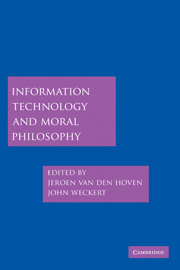Book contents
- Frontmatter
- Contents
- List of Contributors
- Introduction
- 1 Norbert Wiener and the Rise of Information Ethics
- 2 Why We Need Better Ethics for Emerging Technologies
- 3 Information Ethics: Its Nature and Scope
- 4 The Transformation of the Public Sphere: Political Authority, Communicative Freedom, and Internet Publics
- 5 Democracy and the Internet
- 6 The Social Epistemology of Blogging
- 7 Plural Selves and Relational Identity: Intimacy and Privacy Online
- 8 Identity and Information Technology
- 9 Trust, Reliance, and the Internet
- 10 Esteem, Identifiability, and the Internet
- 11 Culture and Global Networks: Hope for a Global Ethics?
- 12 Collective Responsibility and Information and Communication Technology
- 13 Computers as Surrogate Agents
- 14 Moral Philosophy, Information Technology, and Copyright: The Grokster Case
- 15 Information Technology, Privacy, and the Protection of Personal Data
- 16 Embodying Values in Technology: Theory and Practice
- 17 Information Technology Research Ethics
- 18 Distributive Justice and the Value of Information: A (Broadly) Rawlsian Approach
- Select Bibliography
- Index
- References
7 - Plural Selves and Relational Identity: Intimacy and Privacy Online
Published online by Cambridge University Press: 21 July 2009
- Frontmatter
- Contents
- List of Contributors
- Introduction
- 1 Norbert Wiener and the Rise of Information Ethics
- 2 Why We Need Better Ethics for Emerging Technologies
- 3 Information Ethics: Its Nature and Scope
- 4 The Transformation of the Public Sphere: Political Authority, Communicative Freedom, and Internet Publics
- 5 Democracy and the Internet
- 6 The Social Epistemology of Blogging
- 7 Plural Selves and Relational Identity: Intimacy and Privacy Online
- 8 Identity and Information Technology
- 9 Trust, Reliance, and the Internet
- 10 Esteem, Identifiability, and the Internet
- 11 Culture and Global Networks: Hope for a Global Ethics?
- 12 Collective Responsibility and Information and Communication Technology
- 13 Computers as Surrogate Agents
- 14 Moral Philosophy, Information Technology, and Copyright: The Grokster Case
- 15 Information Technology, Privacy, and the Protection of Personal Data
- 16 Embodying Values in Technology: Theory and Practice
- 17 Information Technology Research Ethics
- 18 Distributive Justice and the Value of Information: A (Broadly) Rawlsian Approach
- Select Bibliography
- Index
- References
Summary
INTRODUCTION
With unprecedented global access, speed, and relative anonymity with respect to how one is able to present oneself to and interact with others, computer-mediated communication (hereafter CMC) contexts provide many new worlds through which we may express and develop our identities as persons and form relationships with others. Through text-based e-mail and chat-room style forums, or Web site and Web cam technology, we may present or even ‘showcase’ ourselves to others, and we may enter and contribute to all sorts of communities, such as hobby and mutual interest groups, and develop various sorts of relationships with others. Indeed, for many people, significant aspects of key roles and relationships in their professional, business, and even personal lives are now conducted online.
It makes sense then, to consider if these CMC contexts, where people are increasingly presenting themselves to and undertaking various activities and relationships with others, might tailor the content of these relationships and the self that is presented to others online in any notable ways. For many, opportunities to express and form relationships have been enormously increased by computer communication technology. But what sorts of identities and relationships are really possible online? How might our pursuit of values that constitute and regulate our ideals of personal identity and various significant relationships be sensitive to such communication environments?
It is clear that contextual features of the setting within which we express ourselves to others can significantly influence the content and nature of our communication.
- Type
- Chapter
- Information
- Information Technology and Moral Philosophy , pp. 123 - 141Publisher: Cambridge University PressPrint publication year: 2008
References
- 16
- Cited by



